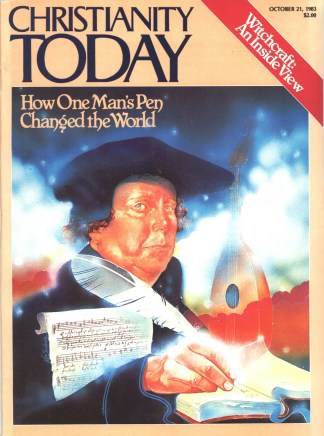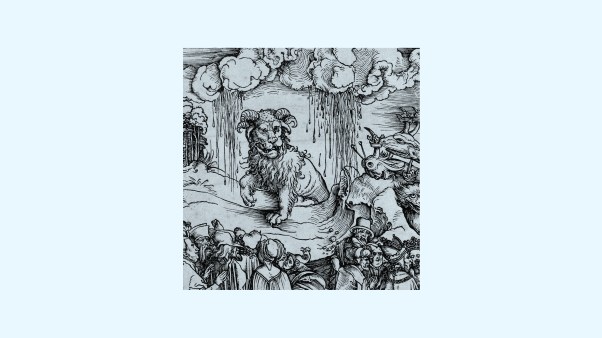A report on who’s been shooting at whom, and why.
When the U.S. Marines entered Lebanon, they were sucked into the vortex of a religious feud that has been swirling long before the U.S. declared its independence from Great Britain. It is small wonder that there has been no peace for the multinational peacekeepers.
The Lebanese political system, with its president, prime minister, and parliament, resembles other modern democracies on the surface. But it remains, in essence, a feudal system. Its main leadership has always been elected from hereditary clan leaders. Lebanese President Amin Gemayel is the heir of a leading Maronite clan, while Walid Jumblatt, a member of parliament and the opposition leader, heads a dominant Druze clan and lives in its medieval castle.
The identity of the Lebanese is determined not so much by national allegiance as by allegiance to village, clan chief, and, above all, to religious group. So in this context, the word Christian is a community and political term more than a religious one.
Neither of the groups recently shooting it out originated in Lebanon, but fled to the isolation of its steep ridges and canyons as persecuted religious minorities.
The Maronites were chased there from northern Syria, where Antioch, the oldest Gentile church, was situated. The early Constantinople-based Christian church was hard on those who deviated from its doctrinal formulations. It excluded the Nestorians from orthodoxy in the early fifth century for overly emphasizing the distinction between the divine Logos and the man Jesus. Then in the mid-fifth century, it pushed out those who maintained that Christ possessed only a divine nature (the Coptic, Armenian, and Syrian Orthodox churches still fit this category). Finally, in the seventh century, the Maronites, following the lead of Bishop Maroun (for whom they are named), finessed a mediating position: that Christ had both divine and human natures but only a divine will. They, too, were persecuted.
The invading Omayyad Muslim caliphs who ruled the area from Damascus until 749, however, gave them a breather for a couple of generations. During this period they flourished. But with the fall of the Omayyads, the Maronites came under such pressure from their new Muslim rulers that they fled south.
In the mountains of northern Lebanon, breathtaking cliffside caves still bear witness to the hermits who inhabited them. The newcomers terraced the mountains and built a network of strategically positioned monasteries. With Muslim populations flanking them along both the coast and the interior valley, they developed a sophisticated system of family-based militias. Down to this day, the bells of village churches summon men to arms as well as to prayer.
The Druzes, too, were pushed out of their original home. Islam was defining its orthodoxy during its early centuries, and an esoteric offshoot of Shiite Islam in Egypt began to take the heat. The disciples of Ismail al-Darazi (for whom they are named) fled to the southern Lebanon range in the eleventh century.
Faced with persecution and infiltration from more orthodox Muslims, the Druzes decided early on to forbid conversion to their religion, and to keep their doctrines secret. Druzes believe their number was determined at the time of Creation, and that when a Druze dies his soul enters the body of a newborn Druze. Their Book of Wisdom is still written in Arabic script only by the hand of a religious leader to bar outside access.
Despite their secrecy, the Druzes have traditionally been among the most tolerant in the region of other faiths. In the sixteenth century, Druze Sheikh Beshir was very open to Christians, and is said to have been a secret convert. He let Maronites expand into the Shouf—the Druze area south of the deep east-west gorge of the Beirut River—with his blessing. They quickly became the largest, most organized, and wealthiest institution in the mountains, which led to demands for power commensurate to their standing.
The Druzes balked at this and went on the offensive in 1860. In the process of expelling the Christians from their own traditional areas—as they are doing again now—they reportedly killed 12,000 Maronites.
But the Maronites had come under the influence of the Western church during the Crusades, had renounced their monotholete heresy in the eighteenth century, and had as a bloc joined the Roman Catholic church. They appealed to Catholic Europe. The French responded, landing troops to restore and protect the peace. That left the Maronites on top, where they have stayed to this day.
The 1860 war left the Lebanon mountain range tacitly divided between the antagonists. With Druzes confined to the Shouf, and Maronites, except for residents of a few isolated Shouf villages, concentrated in the central mountain section called the Metn, and the far north.
That conflict also established the principle that power was related to religious communities. At independence in 1943, this was formally enshrined in the “National Covenant,” dividing government jobs among the 17 recognized religious groupings. But the covenant also tried to put a stop to the religious communities’ habit of appealing to outside powers to intervene on their side whenever they felt threatened. No longer were Christians to seek French or other patronage, nor the Muslims to seek union with Syria.
This religio-political balancing act worked briefly. But it began to come unglued because of demographic changes. Consistently higher birthrates boosted the Muslim population, and in 1948 thousands of Palestinians fled into southern Lebanon from Galilee before the army of the newly formed Jewish state of Israel.
The balance first broke down in the heady Nasser days of the Egyptian-Syrian “United Arab Republic.” Muslims in Lebanon revolted against Maronite domination, and they had Syrian backing. President Camille Chamoun, the clan leader of the Shouf Maronites, appealed to President Eisenhower for aid, and the Marines were sent to Lebanon for seven months in 1958.
Peace held until the expulsion of the PLO from Jordan in 1970 created a new Palestinian influx into Lebanon. The Maronites, alarmed by the erosion of their numerical edge, entered an alliance with the Israelis.
Syria, which prefers to dominate Lebanon indirectly, first sided with the underdog Maronites in the 1975–76 civil war. But the Maronites’ militia (known as the Phalangist militia or the Lebanese Forces) expanded rapidly to 34,000 members and were being supplied by the Israelis. Syria began to fear that this Maronite-Israeli combination threatened its dominance, and abruptly switched sides.
After the 1975–76 civil war, Phalangist militia, controlled by the Gemayel family, took on and defeated the private militias of other Maronite clan leaders—notably that of Camille Chamoun. It then turned to the Palestinian refugee camps crowding the edge of the Metn. The militia massacred Palestinians and Palestinians retaliated by razing a coastal Maronite village south of Beirut. A Phalangist unit of survivors was formed, sworn to avenge the fallen. Almost certainly they were the key element in last year’s massacres in the Shatila and Sabra camps.
In spite of the 1958 and 1975–76 bouts of civil war, the century-old Maronite-Druze territorial standoff held until Israel invaded Lebanon last year to expell the Palestinians. Under cover of its planes and tanks, Israel allowed the Phalangist militia to move into the Shouf, in order, the Israelis were told, to protect the scattered Christian villages there. By accepting the Maronite rationale at face value, the Israeli troops acquiesced in the fateful breaching of the long-standing division of mountain turf.
Now the multinational peacekeeping forces have entered Lebanon to create breathing time for the Lebanese central government to reestablish its authority. But the Druzes see the marines on the narrow coastal strip as allies of their foes. They have been firing down on the leathernecks as fiercely as on the Maronites.
So today, a private army composed largely of thugs, is described as Christian. And priests justify its excesses. Maronite prelate Anthony Karam, as he prayed in a recent memorial mass for Bashir Gemayel, said, “There is nothing left for us but the force you give us, our Lord, to win our peace with our own hands.”










